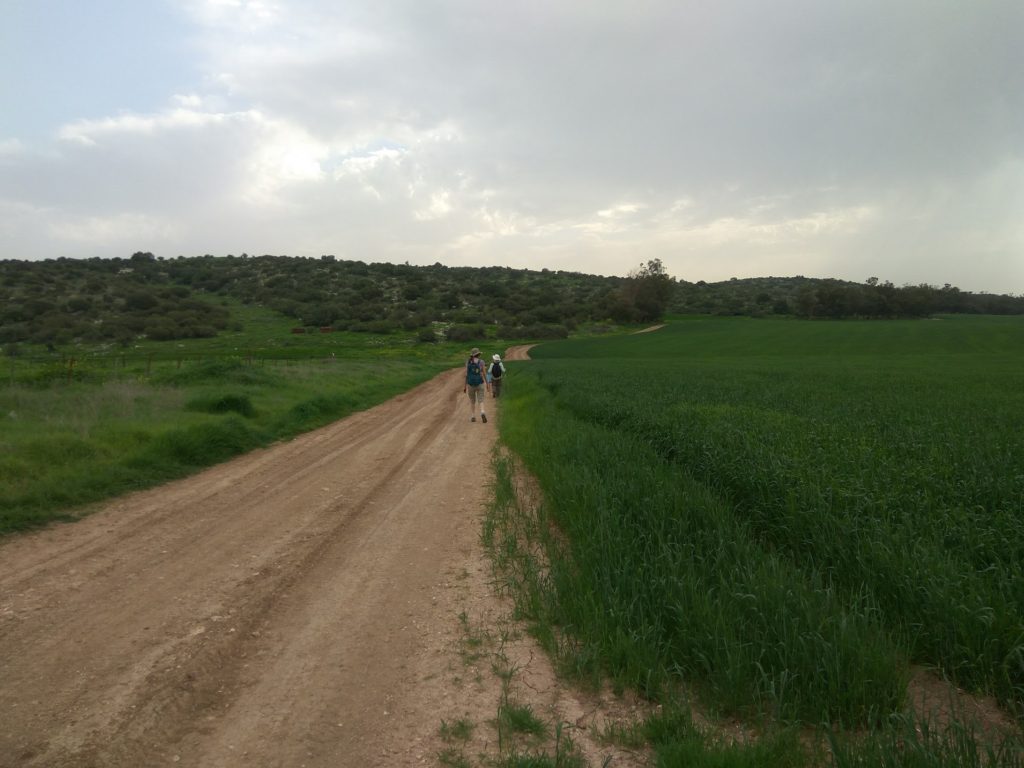Hiking Through Israel’s Spring

I just went on two terrific hikes in the rolling hills southwest of Jerusalem to prepare for a hiking tour I’ll soon be guiding.
“But wait a minute,” a well-meaning friend of mine said. “That’s a lot of extra work you did for that one hike. You sure it’s worth your while?”
Worth my while? Well, for one thing, I’ve got to feel sure about the hiking trail no matter what extra effort it takes. But far more to the point is the fact that it got me out hiking, in the beginnings of an Israeli spring. What could be better than that? I grab at any chance to hike this land, and if it is a stretch I know, then I just open my eyes a little wider and learn it a little more deeply. And now the winter rains have saturated the soil, the earth and rocks are covered with huge expanses of deep emerald grass that make me stop and blink and ask, “Hey, did I make a wrong turn and end up in Ireland?”
Because that is how lush it is. Already along the route we are taking, along a low north-south ridge, the early flowers are popping out, and it is just amazing to be walking among them. The almond trees already opened in January like big round pink puffs of smoke. Red anemones are scattered everywhere. The grass is dusted with mustard. Cyclamens grow on the hills among the rocks and ruined, ancient, mottled stone walls. I can stand on a spot with a one-meter radius (about three feet), and as I slowly turn around I’ll spot four or five species of flowers in that circle.
But remember, this verdancy is bursting in a little splinter of land that is rocky, sun-blasted, and more than half desert. As we walk along, we are just astonished by the beauty. Lines of parallel terraces follow the undulating slopes, with wild mustard spilling over them. In spots it truly feels as if we are walking right through a Biblical landscape.
And the Biblical landscape is edible. My wife, who has learned some foraging knowledge, grazed her way along the trail, nibbling wild asparagus, mustard, sorrel, mallow, milk thistle, sage, fennel, as we walked past flocks of sheep and goats watched by young shepherds. If we return later in the year we can pluck from wild fig trees, wild carob trees, and twisted, gnarled olive trees.
And of course the Bible is filled with pastoral imagery: “The flowers appear on the earth; the time of the singing bird is come, and the voice of the turtledove is heard in our land.”(Song of Songs, 2:10-13)
But jammed in along the twelve-mile trail that we hiked is modern, ancient and Biblical history as well, enough to make my head spin. There’s the valley where David fought Goliath. There is the entrance to a complex of caves and tunnels in which Jewish rebels hid from the Romans. And watch out for that ancient cistern carved right out of the bedrock.
Further south along our route stands a Roman amphitheater where Roman gladiators fought each other and wild animals to the death while spectators screamed and cheered from the stands that still exist. And over there is the actual chute that the lions charged from—looks as if one could dash out right now.
As stunning and intricate as the web of plant life is, it will dry up and be gone within a few months. By mid-May the pale barrenness will return, and carpets of green will become splotches of brown. The Bible was attuned to that as well.
“All flesh is grass, and all its grass is as the flower of the field. The grass withers, the flower fades, when the breath of the Lord blows upon it; surely the people is like the grass. The grass withers, the flower fades, but the word of our God shall last forever.”
(Isaiah 40: 6-8)
So let’s get out there and go hiking together. There might still be some wild asparagus left.
